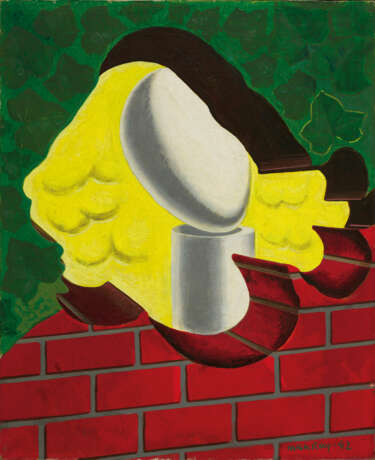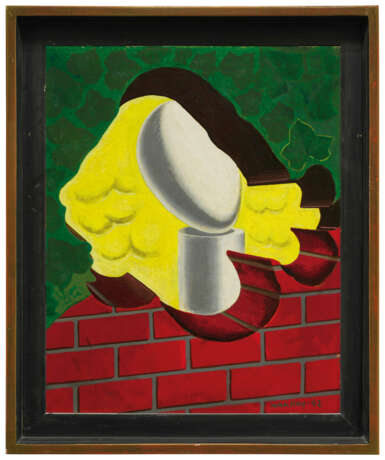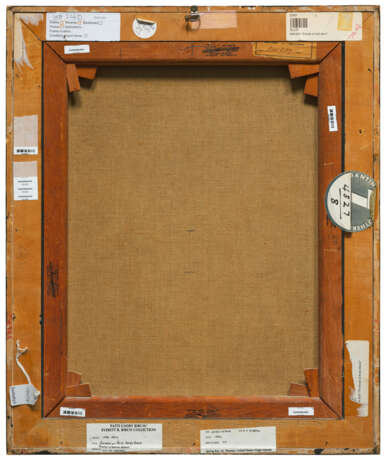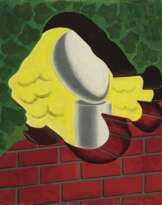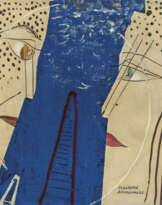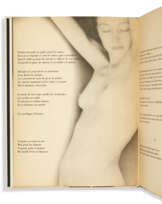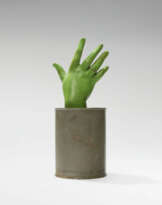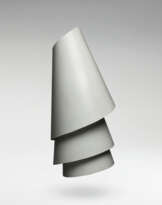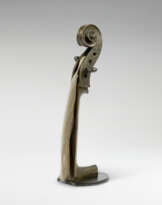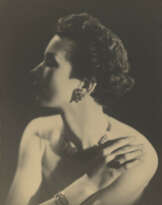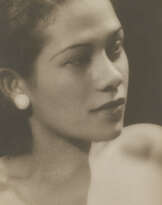ID 929389
Lot 8 | Man Ray (1890-1976)
Estimate value
€ 800 000 – 1 200 000
Portrait (Patti Cadby Birch)
signé et daté 'man Ray. 42' (en bas à droite)
huile sur toile
51.6 x 41.5 cm.
Peint à Hollywood en 1942
signed and dated 'man Ray. 42' (lower right)
oil on canvas
20 3/8 x 16 3/8 in.
Painted in Hollywood in 1942
Provenance
Patti Cadby Birch, New York (acquis auprès de l'artiste)
Patti Birch Trust; vente, Sotheby's, Paris, 13 décembre 2007, lot 29.
Acquis au cours de cette vente par le propriétaire actuel.
Exhibited
Pasadena, Art Institute, Retrospective exhibition, 1913-1944, Paintings, Drawings, Watercolors, Photographs by Man Ray, septembre-octobre 1944, no. 35.
Special notice
Artist's Resale Right ("droit de Suite").
If the Artist's Resale Right Regulations 2006 apply to this lot, the buyer also agrees to pay us an amount equal to the resale royalty provided for in those Regulations, and we undertake to the buyer to pay such amount to the artist's collection agent.
ƒ: In addition to the regular Buyer’s premium, a commission of 5.5%
inclusive of VAT of the hammer price will be charged to the buyer.
It will be refunded to the Buyer upon proof of export of the lot
outside the European Union within the legal time limit.
(Please refer to section VAT refunds)
Post lot text
‘J'aime les mystères, je n'aime pas beaucoup les solutions’.
Man Ray (cité dans M. Ray, Autoportrait (Self-portrait), Paris, 1964).
L’un des grands thèmes de la recherche pluridimensionnelle de Man Ray est l’appréhension du mouvement dans l’image, qu’elle soit peinte ou photographique. Cet artisan de la modernité, emploie -tout sa vie durant- son talent de créateur à approfondir les techniques de représentation du volume et de la perspective. Nourri des débats cubistes et futuristes sur la décomposition du mouvement, l’artiste tente différents procédés techniques et artistiques pour dépasser la platitude de l’image et créer le mouvement par la lumière.
L’apport de la photographie dans cette recherche est majeur. Pour saisir le réel, le photographe -autant que le peintre- s’appuie sur la faculté de mise en action des objets par la lumière, car elle "est un instrument aussi subtil que le pinceau" (cité dans ibid., 1964). Ce talent à représenter le mouvement et l’espace dans les jeux de lumière caractérise l’immense œuvre de Man Ray, qu’elle soit picturale, photographique ou tridimensionnelle. Man Ray invente sans relâche de nouvelles approches stylistiques et de médias variés : cliché-verre, collages, peinture aérographe, tapisserie et cinéma pour donner forme à ses idées. Il produit une oeuvre considérable aussi influente qu’inclassable.
Man Ray, grand imagier et portraitiste du groupe surréaliste découvre par accident en 1922, le procédé du Rayogramme, la photographie sans appareil. Jean Cocteau est le premier à saluer la poésie de ces photos, « sortes de peintures faites avec la lumière » (J. Cocteau, Lettre ouverte à Monsieur Man Ray, Photographe américain, 1922, publiée dans Les Feuilles Libres). Ce procédé scientifique fascine les avant-gardes surréalistes qui considèrent que ces impressions directes de formes sur un papier sensible constituent l’équivalent de l’écriture automatique, chère à André Breton. Man Ray illustre de ses photographies mais aussi de ses collages et dessins de nombreux ouvrages d’André Breton, Paul Éluard, Marcel Duchamp, Robert Desnos… Parallèlement, il peint et mène une réflexion de fond sur la désacralisation de l’objet et l’illusion. Ses travaux donnent naissance aux Assemblages et Objets d’affection, sortes de sculptures baroques et humoristiques qui libèrent les objets de leur rôle conventionnel pour leur donner une réalité nouvelle ! Allant plus loin que Marcel Duchamp qui prive l’objet de sa fonction utilitaire en 1916 avec ses premiers Ready-Mades, Man Ray poursuit l’idée de la démystification et de la déconstruction du sens de l’objet. Cet esprit novateur ouvre la voie à une génération d’artistes modernes du Nouveau Réalisme et de l’art de l’assemblage et préfigure les objets cachés/emballés de Christo ainsi que les Compressions de César.
Au moment de la création du présent portrait, Man Ray vit depuis vingt ans à Paris, lorsque les premiers grondements de la seconde guerre mondiale l’incitent à retourner à New-York. Son pays natal connaît peu son travail et l’artiste laisse à Paris sa notoriété, ses amis et ses archives. Cependant, l’Amérique des années quarante réserve le meilleur des accueils aux artistes réfugiés venant d’Europe et aux Surréalistes en particulier. May Ray y retrouve Salvador Dalí et Gala, André Breton et sa femme, Marcel Duchamp puis Max Ernst et Raoul Ubac, entre autres… Après quelques mois à New-York, il s’installe en 1940 à Hollywood, ville qui fit travailler pendant les années de guerre tant d’intellectuels et d’artistes européens. C’est alors un "véritable lieu de création de tous les mirages" (lettre de Man Ray adressée à Katherine Dreier, 20 février 2021, Archives Katherine Dreier, Beineke Rare Book and Manuscript Library, Yale University Library). Il y retrouve un univers propice à la créativité. Il y rencontre également en août 1940 sa future femme, la danseuse Juliet Browner, qui l’encourage à reprendre la peinture.
La présente œuvre représente Patti Cadby Birch née Garnell (1923-2007), une collectionneuse américaine passionnée dont les goûts éclectiques couvrent des domaines aussi divers que les bijoux du Maghreb et d’Orient et l’Art Moderne et Contemporain. Cette philanthrope fut Conservatrice du département d’Art Islamique au Metropolitan Museum of Art de New-York et en restera un fidèle et généreux soutien. Elle enrichit notamment la collection du Musée par le don d’un tableau de Man Ray, Le Mîme, 1916. La jeune Patti rencontre Man Ray à Paris dans les années trente et sera l’une des plus ferventes admiratrices du talent du peintre. Au début de la seconde Guerre mondiale, la famille de Patti quitte l’Europe pour les Etats-Unis. Ils se retrouvent à Hollywood où Man Ray saisit l’occasion de réaliser deux portraits de la jeune femme, l’un photographique et le présent portrait surréaliste.
Le visage ici représenté est constitué d’un cylindre pour le cou et d’une forme ovale pour représenter le masque anonyme du visage, dont on devine le caractère féminin grâce à l’évocation d’une coiffure blonde. La silhouette inclinée de biais répond - le long de la diagonale opposée - à la partition chromatique du tableau. L’artiste familier des découpages, n’hésite pas à détacher certaines parties des corps pour les ordonner à sa manière et insuffler ainsi à l’image une dimension irréelle. La représentation des corps par des formes abstraites et géométriques permet à l’artiste de conceptualiser l’être-objet.
En 1941, Man Ray commence la série Masques qu’il poursuit jusqu’en 1953. L’artiste se sert alors d’un modèle-mannequin en bois, orientable, dont les éléments ovales et coniques lui inspirent des compositions surréalistes qui sont à rapprocher de la présente œuvre. Léda et le cygne, 1941, montre une belle Léda transformée en robot géométrique et la toile L’Homme infini, 1942, reprend ce procédé pour illustrer la querelle de Breton et Eluard sur leur rupture avec le Surréalisme. Bien souvent, ces oeuvres anthropomorphes aux allures mécaniques évoquent l’incertitude du destin de l’homme, sa solitude et l’absurdité du monde réel.
L’apparition de ce vocabulaire mécanique et géométrique dans l’œuvre de Man Ray est liée à la découverte en 1934 des Objets mathématiques, dénichés avec Max Ernst dans les placards de l'Institut Poincaré à Paris. Ces fascinantes sculptures concrétisant des abstractions mathématiques inspirent à Man Ray une œuvre étonnante. Titrée Les Équations shakespeariennes, 1948, ces œuvres proposent une interprétation des modèles mathématiques qui résistent largement au travail d’interprétation et suggèrent des illusions d’optique. Elle influencent fortement la production de Man Ray tant esthétiquement que philosophiquement.
Dans sa composition, la présente œuvre rappelle la célèbre photographie de Man Ray, Noire et blanche, 1926, où Kiki de Montparnasse (Alice Prin) pose avec un masque africain. Cette composition fait, elle-même, explicitement référence à la Muse endormie, 1910, du sculpteur Constantin Brancusi (1876-1957). Il est intéressant de noter qu’à l’origine, Man Ray souhaitait que cette photo "ressemble vraiment à une étude pour un tableau" (cité dans ibid., 1964). Le clair-obscur de la photographie est restitué dans la peinture grâce à l’alternance des couleurs. Le fond, composé de deux teintes sombres (rouge brique du mur et vert émeraude de la végétation), met en valeur le sujet peint dans des teintes claires (visage et cheveux).
Le faciès pâle et indéchiffrable du présent portrait est comparable au visage fardé au teint opalescent de Patti Cadby Birch. La transgression du postulat traditionnel du visage-miroir-de-l’âme et substrat des émotions, prend ici une allure de questionnement et d’exhortation au mystère. Les deux figures suggèrent le rêve. Man Ray isole délibérément le visage en le sortant de l’espace du réel, l’un par sa beauté éthérée et ses yeux fermés et l’autre par l’absence de matérialisation de ses traits. Man Ray transforme ainsi les sujets en objets, dispositif intellectuel et esthétique auquel l’artiste a souvent recours et notamment dans la fameuse photographie, Le Violon d’Ingres, 1924.
Les femmes sont très présentes dans l’oeuvre de Man Ray ainsi que dans son existence. Le corps féminin est l’un des sujets de prédilection de l’artiste. En dépit de leur représentations très différentes, la photographie exposant la perfection esthétique du modèle et la peinture la suggérant par un champ immaculé, ces deux femmes figées l’une par l’objectif et l’autre par le pinceau, semblent réduites à leur beauté passive et privées de toute possibilité d’action. La femme-muse de Man Ray n’est pas pour autant réduite au seul statut d’objet du désir, elle joue un rôle de premier plan en tant que sujet de l’œuvre d’art à laquelle elle donne vie.
Comme dans toute œuvre d’un artiste inspiré par le Surréalisme, les pistes sont brouillées et le spectateur déconcerté par plusieurs lectures possibles. Si la lumière est la mère des choses visibles, les ombres sont les protagonistes d’une opposition entre les différentes apparences du réel. Dans une représentation réaliste, l’ombre du buste projetée sur le mur de briques ne serait pas conciliable avec les ombres du visage et du cou révélant non pas une, mais deux sources de lumière ! L’ambivalence ne semble pas fortuite. En tordant le regard et en se s’écartant d’une lecture linéaire de l’œuvre, on peut apercevoir une silhouette humaine au travers d’un trou béant percé dans une paroi de briques et de végétation. À la manière d’une illusion d’optique inattendue, le mur brisé nous offre à découvrir un autre univers, métaphore de la face cachée de notre monde ? La brèche percée dans le mur nous laisse deviner l’existence d’un univers joyeux symbolisé par les couleurs claires et l’apparition de cette figure féminine derrière le mur sans relief et monotone de notre quotidien.
La coordination des perspectives est un élément majeur du double fond de ce tableau. La lecture en est troublée par la platitude de la matière et la représentation au même niveau de plans différents. Par l’incohérence du jeu d’ombres et une touche subtile, Man Ray réalise l’ambition posée par les auteurs du Manifeste du surréalisme, 1924, à savoir, "la résolution future de ces deux états, en apparence si contradictoires, que sont le rêve et la réalité, en une sorte de réalité absolue, de surréalité". À la manière d’un rébus, Man Ray codifie les messages symboliques et s’appuie sur la métaphore pour susciter une émotion poétique dans une œuvre abstraite aux facettes multiples.
“I like mystery, I don't much like solutions”.
Man Ray (quote in M. Ray, Autoportrait (Self-portrait), Paris, 1964).
One of the key themes of Man Ray's multidimensional research is the depiction of movement in image, whether painted or photographic. This craftsman of modernity used his creative talent throughout his life to further develop techniques for representing volume and perspective. Fuelled by Cubist and Futurist debates on the decomposition of movement, the artist tried different technical and artistic processes to overcome the flatness of the image and create movement through light.
Photography played a key role in this research. In order to capture reality, a photographer - as much as a painter - relies on the power of light to bring objects into action, for it is “an instrument as subtle as the brush” (quote from ibid., 1964). This talent for representing movement and space in the play on light characterises Man Ray's immense work, whether pictorial, photographic or three-dimensional. Man Ray was constantly coming up with new stylistic approaches and used a variety of media such as glass print, collage, airbrush painting, tapestry and film to give shape to his ideas. He produced a considerable body of work that was both influential and unclassifiable.
Man Ray, the great illustrator and portraitist of the Surrealist group, discovered the Rayogram process, photography without a camera, by accident in 1922. Jean Cocteau was the first to praise the poetry of these photos, “types of paintings made with light” (J. Cocteau, Open letter to Monsieur Man Ray, American photographer, 1922, published in Les Feuilles Libres). This scientific process fascinated the Surrealist avant-garde, who considered these direct impressions of shapes on photographic paper to be the equivalent of the automatic writing advocated by André Breton. Man Ray illustrated numerous works by André Breton, Paul Éluard, Marcel Duchamp and Robert Desnos with his photographs, collages and drawings. At the same time, he painted and reflected on desacralization of the object and illusion. His work gave rise to the Assemblages et Objets d’affection, types of baroque and humorous sculptures that free objects from their conventional role and give them a new reality! Going further than Marcel Duchamp who deprived the object of its utilitarian function in 1916 with his first Ready-Mades, Man Ray pursued the idea of demystifying and deconstructing the meaning of the object. This innovative spirit paved the way for a generation of modern New Realism and assemblage artists and heralded Christo's hidden/packaged objects and César's Compressions.
At the time of creating the attached portrait, Man Ray had been living in Paris for twenty years but then the first rumblings of the Second World War prompted him to return to New York. His native country knew little of his work and the artist left his fame, friends and archives in Paris. However, 1940s America gave the warmest of welcomes to refugee artists from Europe and to the Surrealists in particular. May Ray met up there with Salvador Dalí and Gala, André Breton and his wife, Marcel Duchamp, Max Ernst and Raoul Ubac, among others. After a few months in New York, he moved to Hollywood in 1940, the city that gave work to so many European intellectuals and artists during the war years. It was a “real place for creating all mirages” (quote from a letter from Man Ray to Katherine Dreier, 20 February 2021, Katherine Dreier Archives, Beineke Rare Book and Manuscript Library, Yale University Library). He found a world conducive to creativity. In August 1940 he also met his future wife, the dancer Juliet Browner, who encouraged him to return to painting.
The present work is a portrait of Patti Cadby Birch née Garnell (1923-2007), a passionate American collector whose eclectic tastes spanned areas as diverse as North African and Oriental jewellery and Modern and Contemporary Art. This philanthropist was Curator of the Department of Islamic Art at the Metropolitan Museum of Art in New York and would remain a loyal and generous supporter. In particular, she added to the Museum's collection by donating a painting by Man Ray, Le Mîme, 1916. The young Patti met Man Ray in Paris in the 1930s and became one of the most ardent admirers of the painter's talent. At the outbreak of World War II, Patti's family left Europe for the United States. They met in Hollywood where Man Ray seized the opportunity to make two portraits of the young woman, one photographic and the other our surrealist piece.
The face of our portrait is made up of a cylinder for the neck and an oval shape to represent the anonymous mask of the face, whose feminine character can be assumed from the blonde hair. The silhouette is inclined at an angle and responds - along the opposite diagonal - to the colour partition of the painting. An artist familiar with decoupage does not hesitate to detach certain parts of the body to order them in their own way and thus give the image an unreal dimension. The representation of bodies by abstract and geometric forms allows the artist to conceptualise the object-being.
In 1941, Man Ray began the Masks series, which he continued until 1953. The artist used an adjustable wooden mannequin whose oval and conical elements inspired surrealist compositions similar to our piece. Léda et le cygne, 1941, shows a beautiful Leda transformed into a geometric robot and the painting L’Homme infini, 1942, uses this process to illustrate Breton and Eluard's quarrel over their break from Surrealism. Often, these anthropomorphic artworks with their mechanical appearance evoke the uncertainty of man's destiny, his solitude and the absurdity of the real world.
The appearance of this mechanical and geometric vocabulary in Man Ray's work is linked to the discovery in 1934 of the Objets mathématiques, unearthed with Max Ernst in the cupboards of the Institut Poincaré in Paris. These fascinating sculptures, embodying mathematical abstractions, inspired Man Ray to create an astonishing artwork. Les Équations shakespeariennes, 1948, offer an interpretation of mathematical models that generally resist interpretation and suggest optical illusions. They strongly influenced Man Ray's work both aesthetically and philosophically.
The composition of our piece is reminiscent of Man Ray's famous photograph, Noire et blanche, 1926, where Kiki de Montparnasse (Alice Prin) poses with an African mask. This composition itself makes explicit reference to the Muse endormie, 1910,by the sculptor Constantin Brancusi (1876-1957). It is interesting to note that Man Ray originally intended this photograph to 'really look like a study for a painting' (quote from ibid., 1964). The chiaroscuro of the photograph is reproduced in the painting thanks to the alternation of colours. The background, composed of two dark colours (red brick of the wall and emerald green of the vegetation), highlights the subject painted in light colours (face and hair).
The pale, indecipherable features in our painting are comparable to Patti Cadby Birch’s face with opalescent make-up. The transgression of the traditional premise of the visage-miroir-de-l’âme and essence of emotions, takes on the appearance here of a questioning and a call to mystery. Both figures suggest a dream. Man Ray deliberately isolates the face by taking it out of the space of reality, one by its ethereal beauty and closed eyes and the other by the absence of its features. Man Ray thus transformed subjects into objects, an intellectual and aesthetic technique which the artist often used, notably in the famous photograph, Le Violon d’Ingres, 1924.
Women are very present in Man Ray's work and in his life. The female body is one of the artist's favourite subjects. In spite of their very different representations, the photograph showing the model’s aesthetic perfection and the painting suggesting it through an immaculate field, these two women, one frozen by the lens and the other by the brush, seem to be reduced to their passive beauty and deprived of any possibility of action. Man Ray's female muse is not reduced to the status solely of an object of desire, but plays a leading role as the subject of the work of art which she brings to life.
As in any work by a Surrealism-inspired artist, the tracks are blurred and the viewer is confused by several possible readings. If light is the mother of visible things, shadows are the protagonists of opposing appearances of reality. In a realistic representation, the shadow of the bust projected on the brick wall would not be reconcilable with the shadows of the face and neck revealing not one, but two sources of light! The ambivalence does not seem to be accidental. If you move away from a linear reading of the work, you can see a human figure through a gaping hole in a wall of bricks and vegetation. In the way of an unexpected optical illusion, the broken wall lets us discover another universe, a metaphor for the hidden face of our world? The opening in the wall allows us to guess about the existence of a joyful world symbolised by the light colours and appearance of this female figure behind the flat, monotonous wall of our daily lives.
The coordination of perspectives is a major element of this painting’s double background. It is difficult to interpret due to the flatness of the material and the representation of different perspectives on the same level. The incoherence of the play of shadows and a subtle touch allows Man Ray to achieve the ambition set out by the authors of the Manifeste du surréalisme, 1924, namely, ‘the future resolution of these two states, dream and reality, which are seemingly so contradictory, into a kind of absolute reality, a surreality’. Like in a rebus, Man Ray codifies symbolic messages and uses metaphor to arouse poetic emotion in a multifaceted abstract work.
| Artist: | Man Ray (1890 - 1976) |
|---|---|
| Applied technique: | Oil on canvas |
| Auction house category: | Paintings |
| Artist: | Man Ray (1890 - 1976) |
|---|---|
| Applied technique: | Oil on canvas |
| Auction house category: | Paintings |
| Address of auction |
CHRISTIE'S 9 Avenue Matignon 75008 Paris France | ||||||||||||||
|---|---|---|---|---|---|---|---|---|---|---|---|---|---|---|---|
| Preview |
| ||||||||||||||
| Phone | +33 (0)1 40 76 85 85 | ||||||||||||||
| Fax | +33 (0)1 40 76 85 86 | ||||||||||||||
| Conditions of purchase | Conditions of purchase | ||||||||||||||
| Shipping |
Postal service Courier service pickup by yourself | ||||||||||||||
| Payment methods |
Wire Transfer | ||||||||||||||
| Business hours | Business hours
|
